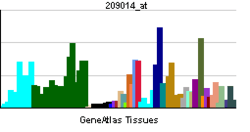MAGED1
Melanoma-associated antigen D1 is a protein that in humans is encoded by the MAGED1 gene.[1][2]
Function
This gene is a member of the melanoma antigen gene (MAGE) family. Most of the genes of this family encode tumor specific antigens that are not expressed in normal adult tissues except testis. Although the protein encoded by this gene shares strong homology with members of the MAGE family, it is expressed in almost all normal adult tissues. This gene has been demonstrated to be involved in the p75 neurotrophin receptor mediated programmed cell death pathway. Three transcript variants encoding two different isoforms have been found for this gene.[2]
Interactions
MAGED1 has been shown to interact with UNC5A,[3] PJA1[4] and XIAP.[5]
References
- ↑ Põld M, Zhou J, Chen GL, Hall JM, Vescio RA, Berenson JR (Sep 1999). "Identification of a new, unorthodox member of the MAGE gene family". Genomics 59 (2): 161–7. doi:10.1006/geno.1999.5870. PMID 10409427. Vancouver style error (help)
- ↑ 2.0 2.1 "Entrez Gene: MAGED1 melanoma antigen family D, 1".
- ↑ Williams ME, Strickland P, Watanabe K, Hinck L (May 2003). "UNC5H1 induces apoptosis via its juxtamembrane region through an interaction with NRAGE". J. Biol. Chem. 278 (19): 17483–90. doi:10.1074/jbc.M300415200. PMID 12598531.
- ↑ Sasaki A, Masuda Y, Iwai K, Ikeda K, Watanabe K (Jun 2002). "A RING finger protein Praja1 regulates Dlx5-dependent transcription through its ubiquitin ligase activity for the Dlx/Msx-interacting MAGE/Necdin family protein, Dlxin-1". J. Biol. Chem. 277 (25): 22541–6. doi:10.1074/jbc.M109728200. PMID 11959851.
- ↑ Jordan BW, Dinev D, LeMellay V, Troppmair J, Gotz R, Wixler L et al. (Oct 2001). "Neurotrophin receptor-interacting mage homologue is an inducible inhibitor of apoptosis protein-interacting protein that augments cell death". J. Biol. Chem. 276 (43): 39985–9. doi:10.1074/jbc.C100171200. PMID 11546791.
Further reading
- Salehi AH, Roux PP, Kubu CJ, Zeindler C, Bhakar A, Tannis LL et al. (2000). "NRAGE, a novel MAGE protein, interacts with the p75 neurotrophin receptor and facilitates nerve growth factor-dependent apoptosis.". Neuron 27 (2): 279–88. doi:10.1016/S0896-6273(00)00036-2. PMID 10985348.
- Masuda Y, Sasaki A, Shibuya H, Ueno N, Ikeda K, Watanabe K (2001). "Dlxin-1, a novel protein that binds Dlx5 and regulates its transcriptional function.". J. Biol. Chem. 276 (7): 5331–8. doi:10.1074/jbc.M008590200. PMID 11084035.
- Kubu CJ, Goldhawk DG, Barker PA, Verdi JM (2001). "Identification of the translational initiation codon in human MAGED1.". Genomics 70 (1): 150–2. doi:10.1006/geno.2000.6356. PMID 11087672.
- Zhang CG, Xing GC, Wei HD, Yu YT, He FC (2001). "[A new melanoma antigen-encoding gene subfamily in human chromosome X]". Yi Chuan Xue Bao 28 (3): 197–203. PMID 11280991.
- Stone B, Schummer M, Paley PJ, Crawford M, Ford M, Urban N et al. (2001). "MAGE-F1, a novel ubiquitously expressed member of the MAGE superfamily.". Gene 267 (2): 173–82. doi:10.1016/S0378-1119(01)00406-1. PMID 11313144.
- Jordan BW, Dinev D, LeMellay V, Troppmair J, Gotz R, Wixler L et al. (2001). "Neurotrophin receptor-interacting mage homologue is an inducible inhibitor of apoptosis protein-interacting protein that augments cell death.". J. Biol. Chem. 276 (43): 39985–9. doi:10.1074/jbc.C100171200. PMID 11546791.
- Sasaki A, Masuda Y, Iwai K, Ikeda K, Watanabe K (2002). "A RING finger protein Praja1 regulates Dlx5-dependent transcription through its ubiquitin ligase activity for the Dlx/Msx-interacting MAGE/Necdin family protein, Dlxin-1.". J. Biol. Chem. 277 (25): 22541–6. doi:10.1074/jbc.M109728200. PMID 11959851.
- Xu YC, Wu RF, Gu Y, Yang YS, Yang MC, Nwariaku FE et al. (2002). "Involvement of TRAF4 in oxidative activation of c-Jun N-terminal kinase.". J. Biol. Chem. 277 (31): 28051–7. doi:10.1074/jbc.M202665200. PMID 12023963.
- Kendall SE, Goldhawk DE, Kubu C, Barker PA, Verdi JM (2003). "Expression analysis of a novel p75(NTR) signaling protein, which regulates cell cycle progression and apoptosis.". Mech. Dev. 117 (1–2): 187–200. doi:10.1016/S0925-4773(02)00204-6. PMID 12204258.
- Williams ME, Strickland P, Watanabe K, Hinck L (2003). "UNC5H1 induces apoptosis via its juxtamembrane region through an interaction with NRAGE". J. Biol. Chem. 278 (19): 17483–90. doi:10.1074/jbc.M300415200. PMID 12598531.
- Matsuda T, Suzuki H, Oishi I, Kani S, Kuroda Y, Komori T et al. (2003). "The receptor tyrosine kinase Ror2 associates with the melanoma-associated antigen (MAGE) family protein Dlxin-1 and regulates its intracellular distribution". J. Biol. Chem. 278 (31): 29057–64. doi:10.1074/jbc.M302199200. PMID 12754255.
- Wen CJ, Xue B, Qin WX, Yu M, Zhang MY, Zhao DH et al. (2004). "hNRAGE, a human neurotrophin receptor interacting MAGE homologue, regulates p53 transcriptional activity and inhibits cell proliferation". FEBS Lett. 564 (1–2): 171–6. doi:10.1016/S0014-5793(04)00353-9. PMID 15094062.
- Bertrand M, Huijbers I, Chomez P, De Backer O (2005). "Comparative expression analysis of the MAGED genes during embryogenesis and brain development". Dev. Dyn. 230 (2): 325–34. doi:10.1002/dvdy.20026. PMID 15162511.
- Tian XX, Rai D, Li J, Zou C, Bai Y, Wazer D et al. (2005). "BRCA2 suppresses cell proliferation via stabilizing MAGE-D1". Cancer Res. 65 (11): 4747–53. doi:10.1158/0008-5472.CAN-05-0018. PMC 3295243. PMID 15930293.
- Xue B, Wen C, Shi Y, Zhao D, Li C (2005). "Human NRAGE disrupts E-cadherin/beta-catenin regulated homotypic cell-cell adhesion". Biochem. Biophys. Res. Commun. 336 (1): 247–51. doi:10.1016/j.bbrc.2005.08.069. PMID 16125672.
- Lim J, Hao T, Shaw C, Patel AJ, Szabó G, Rual JF et al. (2006). "A protein-protein interaction network for human inherited ataxias and disorders of Purkinje cell degeneration". Cell 125 (4): 801–14. doi:10.1016/j.cell.2006.03.032. PMID 16713569. Vancouver style error (help)
